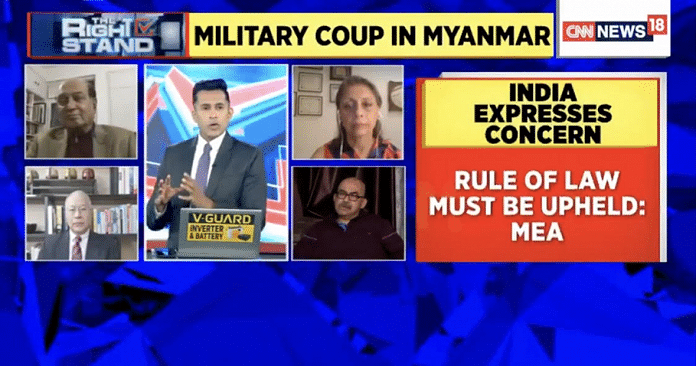
New Delhi: The fortification of Delhi as heavy barricading has come up at different protest sites remained the key focus for multiple news channels on prime time. Except maybe for Arnab Goswami. The biggest story for the Republic TV editor continues to be himself and his channel.
As Republic Bharat marked its second anniversary on air, Goswami became emotional while claiming that the network has worked tirelessly to get “honest, unbiased and courageous” stories to its viewers. He went on to ask why people are scared of his ‘Rashtravadi Patrakarita’.
Journalist Pushpendra Kulshrestha was fulsome in his praise for the channel: “In such a brave and courageous way, you have made sure the channel touches soaring heights in a short span of time.”
Back to the biggest story right now — the farmer protests.
On Aaj Tak’s ‘Khabardaar’, anchor Shweta Singh encountered the heavy barricading at Delhi borders near the farmers’ protests and compared to India’s international borders — “the kind of barricading you’ll see on the international fronts, you see it at Delhi’s borders today,” she said.
Visuals from Delhi’s borders were juxtaposed, dramatically, with those of India’s international borders to drive home the point — “…never thought will have to see such heavy barricading between states,” Singh added while reporting from Ghazipur.
Times Now’s Padmaja Joshi was also concerned with the barricades at Delhi borders, or ‘protective measures’ as she called them.
Joshi said, “Today there was a huge buzz through the day. Over the last 24 hours we have been told, India has turned into a dictatorship. India is a country waging war against its own people, that India has puts its farmers inside a prison, that it’s a country treating its farmers as foreign terrorists.”
She then asked, “Now why have people made such a unsavoury assessment of our country?” She explained that all of this has happened because at three main border points that Delhi shares with its neighbouring states, some “protective measures” have been put in place.
“One, nails that have been laid into the road and cemented in, barricades that have been put one next to the other and there are about five to six of them that have been tied together and then steeled into the road with the help concrete,” she said.
On NDTV 24×7, Vishnu Som called out the ‘fortification’ of three entry roads into Delhi and asked where this stand-off was headed — who will break this pattern and take a step forward, he wanted to know.
Arjunlal Meena, BJP spokesperson said, “The government of India has kept its doors open for dialogue, even after eight rounds of talks failing, the government is inviting the farmers’ leaders for further discussion.”
Kiran Kumar Vissa, All India Kisan Sangharsh Coordination Committee (AIKSCC) hit back — “If the BJP will continue calling people left at protest sites ‘dalals’ then why is the Prime Minister inviting ‘dalals’ for talks now? This rhetoric has to end.”
TV9 Bharatvarsh had a sensational report on protesters being profiled. Ticker headlines like ‘Hinsa padegi bhaari, upravadiyon ki photo jaari’, (violence won’t go unpunished, photos on perpetrators issued) and ‘tirange ka apaan karne wale nahi bachenge’ (those who disrespected the tricolour won’t be spared) flashed across the screen.
For a change, CNN-News 18 went global as anchor Anand Narasimhan discussed the military coup in Myanmar and the detention of Nobel Prize winner Aung Sang Suu Kyi along with other democratic leaders. Narasimhan asked whether China was behind such a development and if so, what repercussions it could have for India.
Manjeet Kripalani from the think tank Gateway House said, “The question is what are we doing about it? India needs to make serious investments in Myanmar”.


(Inputs by Kairvy Grewal)
Subscribe to our channels on YouTube & Telegram
Why news media is in crisis & How you can fix it
India needs free, fair, non-hyphenated and questioning journalism even more as it faces multiple crises.
But the news media is in a crisis of its own. There have been brutal layoffs and pay-cuts. The best of journalism is shrinking, yielding to crude prime-time spectacle.
ThePrint has the finest young reporters, columnists and editors working for it. Sustaining journalism of this quality needs smart and thinking people like you to pay for it. Whether you live in India or overseas, you can do it here.